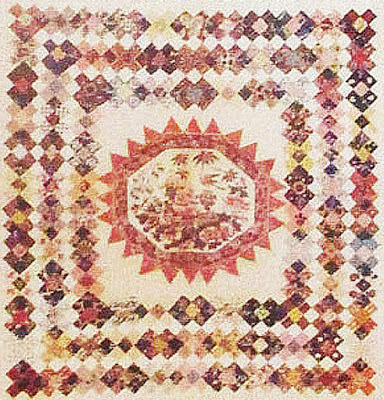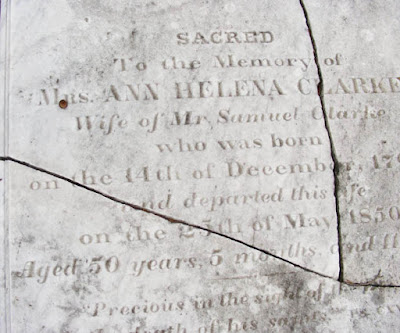Panel #35 is one of two in our database with Asian figures on a theme of Chinoiserie, the French name for the decorating craze interpreting Asian arts for the European market. The fashion for Chinese imagery in furniture like Chinese Chippendale coincides with the fashion for panels in the early 19th century and it's likely the panel above was printed in England in the teens or early 1820s, as were most of the panels we've studied.
Panel #29 also features a garden with a pair in Chinese robes.
#35 is more formal with a dark octagonal border
pinned with oval lozenges.
We have five American quilts with this panel and one two English.
Quilt of many pieces from Patricia Smith's collection
The family story handed down with this quilt is that Captain William H. Torrey from Foxborough, Massachusetts of the 55th Massachusetts Colored Army carried this confiscated quilt north during the Civil War. See a post on the quilt here:
https://civilwarquilts.blogspot.com/2018/08/stolen-quilts-south-carolina-to.html

I've outlined the structure of the large quilt at IQSCM.
A trimmed version of the garden scene is framed by dogtooth triangles
and then border after border of squares.
Attributed to a member of the Alexander family of
Charlotte, North Carolina, Collection of the Hezekiah Alexander House, #78.107
Charlotte, North Carolina, Collection of the Hezekiah Alexander House, #78.107
Here it plays a supporting role to the larger butterfly panel #19. See a post on that panel here:
International Quilt Study Center & Museum #2007.040.001
Little is known about this piece but we can make some guesses.
Southern, 1830-1850.
Again, the panel frames a larger piece (#2) used as yardage for a border
combined with yardage of Panel # 32.
One gets the feeling that Chinese Chippendale furniture and imagery was rather passe by the time quiltmakers here were using this fabric. It seems to be filler rather than focus.
Crib size top. Collection of Polly Mello.
The maker cut three panels in half to make borders.
The fifth quilt is English from Rosemary Blackett-Ord's
Helbeck Collection.
Although our snapshot is indistinct we can see it as a basic construction alternating strips of Panel 35 with strips of Panel 32 framed by chintz florals. The panels seem to be of the same size and same repeat proportion.
Number 32 is unusual in that it has butterflies in the corners (more about #32 later). We see the same butterfly in the block below.

Broderie Perse block signed
Ann Helen(a?) Bender? Clarke, B Island
1849
The sixth quilt is an unfinished album, a collection of 25 blocks at Colonial Williamsburg, donated in 2002 by the family who believe it to have been intended for Mary B. Clarke of Beech Island, South Carolina before her wedding to David H. Porter in 1855. The blocks are dated 1848, 1849 & 1850.
This seamstress trimmed the frame from Panel #35 and added more flowers and the buttefly over the seam lines. This is the only colorway we have seen of the fabric.
Colonial Williamsburg's catalog describes the "flower garden scene. A Chinese man with a pole is harvesting a pod from a branch. A female figure is seated nearby; there is a basket at her feet. In the center is an urn and perched on top is a parrot that appears to be tethered by the female. Fluttering overhead is a butterfly. The flowers are roses, lotus blossoms and leaves. The colors are reds, greens, blues, whites and browns."
Ann Helena Bender Clarke who signed the block was Mary Clarke Porter's mother, married to Samuel Clarke of Beech Island, which is in Aiken County on the Savannah River near Georgia. Ann died in 1850 at the age of 50, according to her tombstone. Reason enough to leave an album unfinished?
See her grave site:
https://www.findagrave.com/memorial/33286264/ann-helena-clarke
And her block:
UPDATE: Christopher Wilson Tate showed an English frame quilt at the 2018 Houston Quilt Market.
Teri & Kara at the Through the Needle's Eye blog took a good photo.
That makes two British examples.
Reproduction Fabrics did a copy of panel #35 a few years ago
but it's out of print now.
What Can We Learn From Panel #35?
I've outlined the structure of the large quilt at IQSCM.
International Quilt Study Center & Museum #2007.040.001
111" x 107"
The design is nicely proportioned and rather simple: making a good quilt to copy. You'd start with an appliqued center square (Broderie Perse style) composed of a large a central panel, four palm trees, four small birds and two butterflies. How long could that take?
The photo at IQSCM is so good I can see the seam lines around the applique, which
indicate the center panel was cut as an oval and the smaller pieces trimmed pretty closely.
Then four chintz borders of panels and stripes. Of course, obtaining panels and large-scale stripes is the hard part. Certainly, piecing would be easy and take no time at all. Then you could have the top quilted in an allover design of scallops. You'd have a spectacular bedcover with little investment of labor.
On the other hand, I am not going to recommend you copy this quilt from Patricia Smith's collection.
And I am not going to count the pieces. You would really have to love handpiecing (probably piecing over paper) to make this quilt, a long-time project of small squares organized in shaded bands with a chintz stripe border framing a center panel. It looks to be the dedicated work of a seamstress with a lot of scraps---cabbage, maybe, small pieces left over from a dressmaking or clothing business?
We have two very different quilt styles here---the pieced squares a labor of love; the Broderie Perse, perhaps, a labor for money. Looking at many panel quilts we are struck by how simple they are: Borders of chintz strips framing showy centers quilted in an allover design. Below a few very basic constructions.
Collection of the Charleston Museum, Unknown maker. Panel #2.
All you needed was a good supply of chintz (panel or not), some skillful seamstresses, one woman with a good design sense and a customer base. We bet there was someone in Charleston or Columbia, South Carolina who had all that. Finding such similar quilts in so many antebellum aristocratic families indicates these were luxury goods, not made by plantation owners but purchased in the cities like their silver and porcelain.
Quilt from Woodard & Greenstein's inventory.
Broderie Perse/chintz borders.
Unknown maker, unknown place.
From an eBay auction.
Bluejays and cactus borders
Found in Pennsylvania.















































































